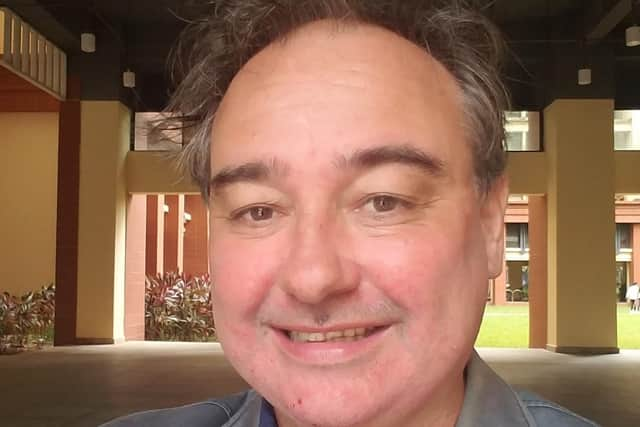Bram Stoker scholar speaks of Whitby's link to Dracula and tells of his own debut gothic novel
In the Chinese region of Macau, Matthew Gibson is nearly 6,000 miles away from the Yorkshire town that provided Bram Stoker with a name for his famed vampire – Dracula.
But as an expert in the Gothic, it would be remiss of him not to have walked the streets of Whitby where the author found inspiration all those years ago – and what Gibson doesn’t know about Stoker, well, it isn’t worth knowing.
Advertisement
Hide AdAdvertisement
Hide AdCurrently an Associate Professor of English Literature at the University of Macau, Gibson is a leading scholar on both Stoker and the Gothic. His latest project, however, is not a work of academia.


Published to coincide with what would have been Stoker’s birthday earlier this month, Gibson has made his first venture into the world of fiction with his debut novel Mr Stoker and the Vampires of the Lyceum. As the name suggests, he’s stuck with what he knows best.
“It’s an imaginative, fictional re-understanding of how it is that Bram Stoker came to write Dracula,” he explains. "I really wanted to write a novel that was a kind of prequel to Dracula, both a historical novel and a gothic crime novel.”
Set against the backdrop of the serial killings in Victorian London, the book features Stoker, acting manager of the city’s Lyceum and aspiring, future author of Dracula, as the somewhat accidental hero at its centre.
Advertisement
Hide AdAdvertisement
Hide AdA young actress has been attacked, suffering peculiar bite wounds to her neck; an event that announces a series of strange, vampiric happenings and thrusts an unwitting Stoker into the limelight, and the action.
Increasingly perplexed by the unsettling behaviour of his 'Guv’nor’, the brilliant but mercurial actor Henry Irving, and Irving’s acclaimed leading lady, Ellen Terry, Stoker soon starts suspecting the worst. Then, another attack reveals a vicious Prussian baron, returned to London as a vampire seeking revenge.
Gibson’s novel blends fact and fiction, in part based on real people, events and circumstance. It brings into the spotlight little-known, but real, people from London’s theatre history and imagines what might have inspired Stoker – already the author of a number of undistinguished novels – to write his masterpiece.
Back in reality, Whitby was part of that story. “He started going on holiday in Whitby just after he’d had the idea of doing a vampire novel and everything there really excited him,” says Gibson. "He made copious notes about the town and its legends, some of which come into the novel itself.
Advertisement
Hide AdAdvertisement
Hide Ad"Then he carried on reading books about Eastern Europe and... he took superstitions, history, some of the manias of the day like mesmerism and the rise of the new woman and put it into the fabulous novel which we all know as Dracula.”
Stoker’s visit to Whitby in 1890 was particularly influential, providing him both with atmospheric locations for his novel and a name for his famous vampire.
In Whitby’s public library, for example, he found a book recording the experiences of a British consul in Bucharest, William Wilkinson. Wilkinson mentioned a 15th-century prince called Vlad Tepes who was said to have impaled his enemies on wooden stakes; he was known as Dracula.
Stoker also came across the tale of a shipwreck of a Russian vessel called the Dmitry. In his novel, this becomes the transport on which Dracula travels.
Advertisement
Hide AdAdvertisement
Hide Ad“He reproduces the topography and geography of Whitby really well in the novel too," Gibson says. “He describes East Cliff, St Mary’s Church, Whitby Abbey, and he was fascinated by the stories of empty graves.
"Some were artificial with no bodies within them, marking people who died at sea and whose families wanted to have funerals. That really excited him - where else would Dracula want to go except a place full of empty tombs?
“[Stoker] really loved the architecture and the whole shape of [Whitby] and having been there, I agree with him…Even if there were no stories attached to it, Whitby is a fantastically atmospheric place.”
The town, where last year a mass gathering of people dressed as vampires broke a world record, is not the only spot in the region that has been key in Gibson’s research of Stoker. The Brotherton Library, at the University of Leeds, is home to Stoker correspondence and manuscripts, which have helped to inform his scholarship.
Advertisement
Hide AdAdvertisement
Hide AdAfter studying English and French at the University of Birmingham, Marlborough-born Gibson’s first academic interest was actually the Irish poet and writer W.B. Yeats.
But he then spent time working in Poland and Bulgaria, sparking an interest in the histories and cultures of both places, as well as the literature set in or inspired by the countries.
A fascination for the Gothic was piqued and Gibson’s work includes the academic book, Dracula and the Eastern Question, as well as contributions to Bram Stoker and the Late Victorian World and The Cambridge Companion to Dracula. He is also curator of Stoker resources for Oxford Bibliographies.
“For someone who has written lot of scholarship, to finally bring out a creative work is really exciting and a very different experience to anything I’ve done before,” he reflects.
Advertisement
Hide AdAdvertisement
Hide AdAs for the enduring appeal of vampirism, “literarily, we love vampires because we can see anything in them,” he muses.
“People can portray them sympathetically or they can portray them negatively. They are that which threatens but they are also that which represent the marginalised.”
Mr Stoker and the Vampires of the Lyceum by Matthew Gibson is published by The Book Guild and out now.
